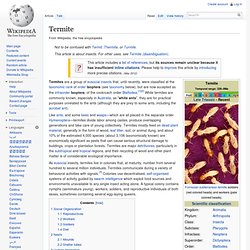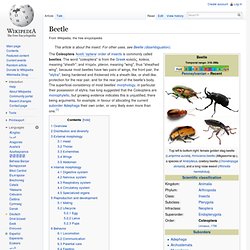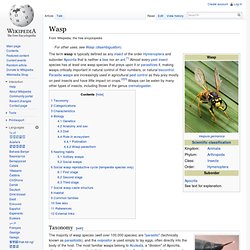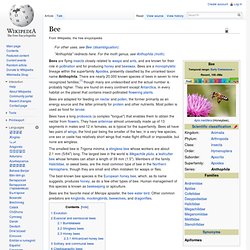

Insect.
Termite. Like ants, and some bees and wasps—which are all placed in the separate order Hymenoptera—termites divide labor among castes, produce overlapping generations and take care of young collectively.

Termites mostly feed on dead plant material, generally in the form of wood, leaf litter, soil, or animal dung, and about 10% of the estimated 4,000 species (about 3,106 taxonomically known) are economically significant as pests that can cause serious structural damage to buildings, crops or plantation forests. Termites are major detritivores, particularly in the subtropical and tropical regions, and their recycling of wood and other plant matter is of considerable ecological importance. As eusocial insects, termites live in colonies that, at maturity, number from several hundred to several million individuals. Social Organization[edit] Reproductives[edit] At maturity, a primary queen has a great capacity to lay eggs. Workers[edit] Worker termite Soldiers[edit] Diet[edit] Termite Fecal Pellets. Beetle.
Overview[edit] The Coleoptera include more species than any other order, constituting almost 25% of all known types of animal life-forms.[2][3][4] About 40% of all described insect species are beetles (about 400,000 species[5]), and new species are discovered frequently.

Some estimates put the total number of species, described and undescribed, at as high as 100 million, but a figure of one million is more widely accepted.[6] The largest taxonomic family is commonly thought to be the Curculionidae (the weevils or snout beetles), but recently the Staphylinidae (the rove beetles) have claimed this title. [citation needed] The diversity of beetles is very wide. They are found in all major habitats, except marine and the polar regions. Conversely, beetles are prey of various invertebrates and vertebrates, including insects, fish, reptiles, birds, and mammals. Species in the Coleoptera have a hard exoskeleton, particularly on their forewings (elytra, singular elytron). Head[edit] Wasp. The term wasp is typically defined as any insect of the order Hymenoptera and suborder Apocrita that is neither a bee nor an ant.[1] Almost every pest insect species has at least one wasp species that preys upon it or parasitizes it, making wasps critically important in natural control of their numbers, or natural biocontrol.

Parasitic wasps are increasingly used in agricultural pest control as they prey mostly on pest insects and have little impact on crops.[2][3] Wasps can be eaten by many other types of insects, including those of the genus crematogaster. Taxonomy[edit] The suborder Symphyta, known commonly as sawflies, differ from members of Apocrita by lacking a sting, and having a broader connection between the mesosoma and metasoma. In addition to this, Symphyta larvae are mostly herbivorous and "caterpillarlike", whereas those of Apocrita are largely predatory.
Categorizations[edit] The various species of wasps fall into one of two main categories: solitary wasps and social wasps. Bee. Bees are flying insects closely related to wasps and ants, and are known for their role in pollination and for producing honey and beeswax.

Bees are a monophyletic lineage within the superfamily Apoidea, presently classified by the unranked taxon name Anthophila. There are nearly 20,000 known species of bees in seven to nine recognized families,[1] though many are undescribed and the actual number is probably higher. They are found on every continent except Antarctica, in every habitat on the planet that contains insect-pollinated flowering plants. The smallest bee is Trigona minima, a stingless bee whose workers are about 2.1 mm (5/64") long. The largest bee in the world is Megachile pluto, a leafcutter bee whose females can attain a length of 39 mm (1.5"). The best-known bee species is the European honey bee, which, as its name suggests, produces honey, as do a few other types of bee. Bees are the favorite meal of Merops apiaster, the bee-eater bird.
Evolution Bumblebees Stingless bees.